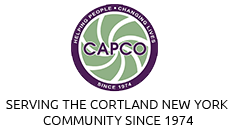The Prosperity Summit is the next step in Cortland County’s journey to becoming an Opportunity Community. The Prosperity Summit follows the Leadership for Change event held on March 18th. The Summit will take place on Thursday, May 9, 2019 at Grace Christian Fellowship in Cortland, NY from 9:00am-1:00pm. Please contact Joyce Allen, Family Development Advocate, to learn more and RSVP at 607-753-6781.
The Opportunity Community Model
The Opportunity Community (OC) model is a national movement designed to create the types of communities we all want to live in. This can be achieved by increasing prosperity for the people living in the crisis of poverty. Dr. Donna M. Beegle combined her experience of living for 28 years in extreme migrant labor poverty, with 20 years of studying and working with communities to create a research-based model for assisting people to move out — and to stay out — of poverty. At the core, the (OC) model addresses seven key issues that prevent us from reducing poverty:
- No clear definition of poverty.
- Varying views of the causes of poverty.
- Education about poverty and its impacts on people provided by the media which promote stereotypes.
- Resolutions, actions, programs, funding allocations and policies are created without the voices of people from generational, working class, immigrant, and situational poverty.
- Efforts to eradicate poverty are isolated and focused on (at best) assisting people to cope with current poverty conditions.
- The “Deficit” model is the primary framework for addressing poverty.
- Economic development is misaligned with the human capital available.
The OC model employs a comprehensive approach that builds on the existing strengths of people in poverty, business, social service, education, healthcare, justice, faith-based organizations and community members to make a difference for their region. This model has similar components as the Collective Impact process, Tamarack’s Vibrant Communities Model, and the Circles Campaign for engaging diverse support from the community. However, the OC model goes beyond building collaborations and partnerships. At its core, the OC model:
- Serves people from generational, working class, situational, and immigrant poverty.
- Provides structure for a better-connected community network resulting in a more effective and efficient poverty-fighting system.
- Provides community-wide education to increase awareness and understanding about the real causes of poverty — Educating people living in poverty (Neighbors) and volunteers (Navigators and Specialty Navigators) — then connecting Navigators and Neighbors in strong relationships.
- Trains community professionals to serve as Specialty Navigators and support the efforts of Navigators who are working to access resources and opportunities for their neighbors.
- Increases engagement of sectors of the community not previously involved in fighting poverty.
- Builds capacity of helping professionals who serve people in poverty.



